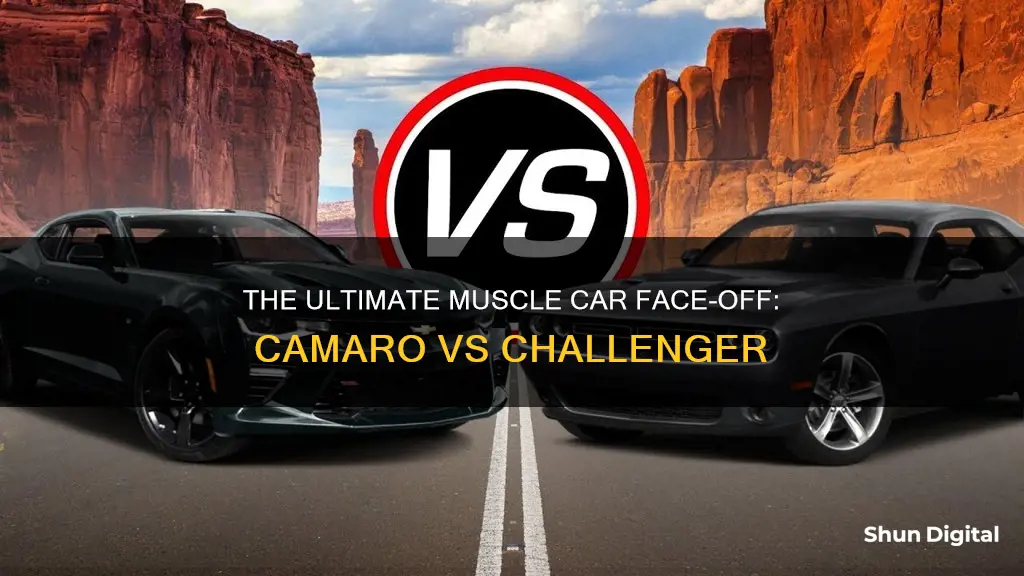
The Chevy Camaro and the Dodge Challenger are two of the big three American muscle cars. Both cars offer powerful engines and sporty looks at prices much lower than their equally powerful European competitors. While the Camaro is more fun to drive, the Challenger is faster and more powerful.
What You'll Learn
- The Camaro is nimbler, but the Challenger is more powerful
- The Camaro is cheaper, but the Challenger has more space
- The Camaro has a convertible option, but the Challenger has all-wheel drive
- The Camaro has better safety ratings, but the Challenger has a better infotainment system
- The Challenger is an old-school muscle car, while the Camaro is more modern

The Camaro is nimbler, but the Challenger is more powerful
The Camaro offers excellent handling and a choice of strong engines, including a 2.0-liter 4-cylinder engine with 275 horsepower and a supercharged V8 with 650 horsepower. The standard transmission is a 6-speed manual, but there is also an 8-speed automatic option and a 10-speed automatic in the top ZL trim. The Challenger, on the other hand, offers a choice of very powerful engines, ranging from a 303-horsepower V6 to an 807-horsepower supercharged V8, making it one of the most powerful production cars available. The V6 Challengers are available with all-wheel drive, while the upper trims are rear-wheel drive and come standard with a 6-speed manual transmission.
The Camaro's compact size makes it less practical for passengers and cargo. The back seats are cramped, and the trunk is tiny, with a narrow opening. In contrast, the Challenger is spacious and comfortable, even for large drivers. It offers plenty of room for five passengers and their cargo, with a large trunk that makes it a decent road trip vehicle.
When it comes to looks, the Challenger boasts a classic retro styling that has stood the test of time, bearing a strong resemblance to the 1970s original. The Camaro, on the other hand, updated its front and rear styling in 2018, moving away from the classic look, which has received mixed reviews from longtime Chevy Camaro fans.
In terms of infotainment, both cars offer modern conveniences. The Camaro's infotainment system is fast and easy to use, with Apple CarPlay, Android Auto, a Wi-Fi spot, and other standard features. The Challenger also comes equipped with Dodge's top-rated Uconnect interface, allowing for phone integration, and the base model includes a 276-watt Alpine sound system.
While both cars offer advanced safety features and have earned 5-star NHTSA safety ratings, the Camaro stands out for its forward collision alert and blind-spot warning systems, as well as Chevy's Teen Driver technology. The Challenger, on the other hand, offers features like forward collision warning, adaptive cruise control, anti-lock brakes, traction control, and more.
When it comes to pricing, the Camaro is more affordable, starting at $25,000, while the Challenger has a higher starting price of $30,000. However, the Challenger's powerful engines, spacious interior, and performance make it a high-value option for those seeking a genuine muscle car experience.
Surveillance Cameras: Spotting and Avoiding Them
You may want to see also

The Camaro is cheaper, but the Challenger has more space
The Chevrolet Camaro and the Dodge Challenger are both iconic American muscle cars. While both cars offer sporty looks and powerful engines, there are some key differences between the two.
The Camaro has a lower starting price, with an estimated cost of around $25,000 for the 2022 and 2024 models. In comparison, the 2021 Challenger starts at $28,295, while the 2022 model is estimated to start at $30,000. The Camaro's lower price point makes it an attractive option for those looking for a blend of power and affordability.
However, one of the Challenger's advantages is its spacious interior. It is the largest in its class, offering plenty of room for passengers and their cargo. The Challenger has a usable back seat, making it a better choice for those who need to transport more than two people regularly. In contrast, the Camaro's backseat is very cramped, and the trunk is also small. The Challenger's trunk provides more than 16 cubic feet of storage space, making it a more practical option for long road trips.
The Camaro's infotainment system is user-friendly and responsive, featuring wireless Apple CarPlay and Android Auto, Wi-Fi, and two USB ports. However, the Camaro's infotainment display is positioned awkwardly and can be hard to read at times. The Challenger also comes equipped with a top-rated infotainment system, Uconnect, which allows for easy integration with your phone. It also features a powerful sound system, even in the base model.
When it comes to performance, both cars offer a range of powerful engine options. The Camaro has a standard power output of 335 horsepower, while the Challenger offers 305 horsepower in its base model. However, the Challenger has a higher-rated optional engine, delivering 485 horsepower compared to the Camaro's 455 horsepower upgrade. Both cars also have specialized models optimized for the track or drag strip, providing even more power and performance.
In conclusion, while the Camaro is cheaper and offers excellent handling and a range of power options, the Challenger stands out for its spacious interior, comfortable ride, and modern features. If you're looking for a muscle car that provides more space and a more comfortable driving experience, the Challenger is the better choice. However, if you prioritize price and don't need the extra space, the Camaro could be the better option.
Camera Tickets: Insurance Impact and What You Need to Know
You may want to see also

The Camaro has a convertible option, but the Challenger has all-wheel drive
The Chevrolet Camaro and the Dodge Challenger are two iconic muscle cars with a lot of history. While both cars offer powerful performance and distinctive styling, there are some key differences that set them apart. One notable difference is that the Camaro has a convertible option, while the Challenger offers all-wheel drive.
The Camaro's convertible option adds an element of open-air freedom and style to the driving experience. Introduced in 2011, the Camaro Convertible has gone through several iterations, each offering a unique blend of performance and design. The convertible body style gives the Camaro a more leisure-oriented appeal, making it perfect for cruising on a sunny day. The latest Camaro convertible models feature modern updates such as LED dual headlights and a reshaped hood, enhancing its appeal to the younger generation.
Under the hood, the Camaro convertible offers a range of engine options, including turbocharged inline-four and V6 engines. The 2019 model, for example, came equipped with a 2.0-litre turbo engine, delivering 275 horsepower and 400 lb-ft of torque. This combination of power and fuel efficiency allows the Camaro convertible to offer a balanced driving experience, perfect for both city traffic and open-road cruising.
On the other hand, the Dodge Challenger stands out as the world's first and only muscle coupe with available all-wheel drive. This all-wheel-drive system enhances the Challenger's versatility and traction, making it a capable car not just for the track but also for everyday use. With its V6 engine, the Challenger focuses on fuel efficiency while still providing strong acceleration when needed. The all-wheel-drive option adds an extra layer of confidence and control, especially in varying weather and road conditions.
The Challenger's all-wheel-drive system complements its spacious and comfortable interior. The Challenger offers more passenger room than the Camaro, making it a more practical choice for those who need a muscle car that can accommodate larger drivers and passengers. Additionally, the Challenger's trunk provides over 16 cubic feet of storage space, making it more suitable for long road trips or hauling extra gear.
In conclusion, while both the Camaro and the Challenger offer unique features and capabilities, the Camaro's convertible option appeals to those seeking open-air driving pleasure and style. In contrast, the Challenger's all-wheel drive provides enhanced traction, versatility, and space, making it a more practical choice for those needing a muscle car that can handle various driving conditions and accommodate more passengers and cargo. Ultimately, the decision between the Camaro and the Challenger depends on individual preferences and specific needs.
Breathalyzers and Cameras: What's the Link to Your Privacy?
You may want to see also

The Camaro has better safety ratings, but the Challenger has a better infotainment system
When it comes to choosing between the Chevy Camaro and the Dodge Challenger, there are several factors to consider. Both cars have their pros and cons, and it ultimately depends on what the buyer values most.
One factor to consider is the infotainment system. The Camaro's infotainment system is fast and easy to use, and it comes standard with Apple CarPlay, Android Auto, and a Wi-Fi spot, which is impressive for a vehicle in this price range. However, the Challenger surpasses the Camaro in this aspect with its top-rated Uconnect interface. Even the most affordable Challenger model comes equipped with this system, allowing for seamless integration of your phone so you can stay connected on the road. The base model also includes a powerful Alpine sound system.
On the other hand, when it comes to safety, the Camaro has an edge over the Challenger. The Camaro has received top safety ratings from organisations like the NHTSA and the IIHS. It offers features such as forward collision alert, lane change alert, and blind-spot warning. Additionally, Chevy's Teen Driver technology is a valuable feature for parents who want to supervise their children as they start driving. The Camaro also has standard safety features across all models, including five airbags, ABS, disc brakes, electronic stability control, traction control, brake assist, and daytime running lights.
In contrast, the Challenger has received lower safety ratings. While it does offer some advanced safety features, such as forward collision warning, adaptive cruise control, and blind-spot monitoring, its crash test results are less impressive. The IIHS gave the Challenger lower scores in the small overlap front and moderate overlap front tests, indicating room for improvement in crashworthiness.
Therefore, when comparing the Camaro and the Challenger, it's clear that each has its strengths and weaknesses. The Camaro boasts superior safety ratings, giving buyers peace of mind, while the Challenger takes the lead in infotainment, providing a more advanced and integrated experience. Ultimately, the decision between the two depends on the buyer's priorities and specific needs.
It's worth noting that other factors come into play when comparing these two vehicles, such as design, performance, and price. However, in terms of safety and infotainment, the Camaro and Challenger each have their unique advantages, allowing buyers to make an informed decision based on their specific requirements.
Locking Camera Focus: A Guide to Mastering Sharp Photography
You may want to see also

The Challenger is an old-school muscle car, while the Camaro is more modern
The Dodge Challenger and the Chevy Camaro are both muscle cars, but they offer very different experiences. While the Challenger embodies the old-school muscle car look and feel, the Camaro has a more modern sports car feel.
The Challenger is built on a platform that has been unchanged since 2008, giving it a classic retro styling that still looks great even after 50 years. On the other hand, the Camaro, which was all-new in 2016, updated its front and rear styling in 2018, moving away from the classic look. The Camaro's retro-modern look may be inspired by the first-generation car of the late 1960s, but once you step inside, it feels more like a sports car than a traditional muscle car. The driver sits low, the dashboard sits high, and the back seat is not very spacious.
The Challenger is the larger and heavier car of the two, and it also has a more spacious interior. It offers comfortable accommodations for both the driver and passenger, and it's the only one of the two cars with a back seat that can comfortably seat adults. The Challenger also has a full-size trunk, providing more than 16 cubic feet of storage space, compared to the Camaro's 9.1 cubic feet.
When it comes to performance, the Camaro's 2.0-liter turbocharged four-cylinder engine delivers a healthy 335 horsepower, allowing it to hit 60 mph in around 5.1 seconds. The Challenger's base V6 engine produces 305 horsepower, but its top-rated optional engine puts out 485 horsepower, outperforming the Camaro's 455-horsepower upgrade. The Challenger also has a lineup of powerful V8s, including the SRT Hellcat Redeye, which produces nearly 800 horsepower.
In terms of price, the Camaro is the more affordable option, with a starting price of just over $26,000. The Challenger has a higher starting price of $29,680, but it offers more features and a higher level of performance.
Both cars have their pros and cons, and the choice between the two ultimately comes down to personal preference. If you're looking for a more modern sports car feel, the Camaro might be the better choice. But if you prefer the old-school muscle car look and performance, the Challenger could be the perfect option.
Clip Studio's Camera Raw Mode: Pros and Cons
You may want to see also
Frequently asked questions
The Chevy Camaro is faster than the Dodge Challenger. The Camaro's V6 engine can accelerate from 0 to 60 mph in around 5.1 seconds. The Dodge Challenger, on the other hand, is designed for both everyday use and the track, focusing on fuel efficiency while still offering strong acceleration.
The 2022 Chevy Camaro offers a range of engine options, from a 275-hp 2.0-liter 4-cylinder to a 650-horsepower supercharged V8, with a regular V8 and a V6 in the middle. The 2022 Dodge Challenger also provides a choice of powerful engines, starting with a 303-horsepower V6 and going up to an 807-hp 6.2-liter supercharged V8.
The Chevy Camaro has limited interior space, with a cramped backseat and a small trunk. The Dodge Challenger, being a larger car, offers more interior and trunk space, making it a more comfortable option for passengers.
Both the Chevy Camaro and the Dodge Challenger have received 5-star NHTSA safety ratings. The Camaro is known for its excellent safety features, including forward collision alert and blind-spot warning. The Challenger also offers advanced safety technologies such as forward collision warning, adaptive cruise control, traction control, and more.







